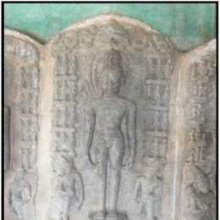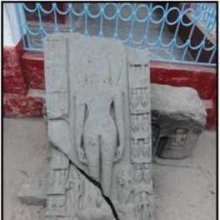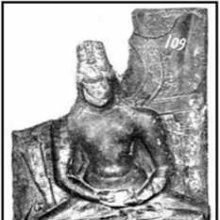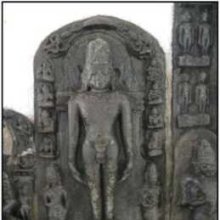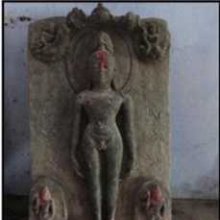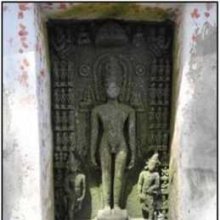Rishabhanatha, Rishabha-natha, Ṛṣabhanātha: 2 definitions
Introduction:
Rishabhanatha means something in Jainism, Prakrit. If you want to know the exact meaning, history, etymology or English translation of this term then check out the descriptions on this page. Add your comment or reference to a book if you want to contribute to this summary article.
The Sanskrit term Ṛṣabhanātha can be transliterated into English as Rsabhanatha or Rishabhanatha, using the IAST transliteration scheme (?).
Images (photo gallery)
(+45 more images available)
In Jainism
General definition (in Jainism)
Source: Wisdom Library: JainismṚṣabhanātha (ऋषभनाथ) is another name for Ṛṣabha, the first Tīrthaṅkara (Janism recognizes 24 such teachers or Siddhas). His colour is gold (kāñcana), according to Aparājitapṛcchā (221.5-7). His height is 500 dhanuṣa (a single dhanuṣa (or, ‘bow’) equals 6 ft), thus, roughly corresponding to 914 meters. His emblem, or symbol, is a Bull.
Ṛṣabhanātha’s father is Nābhi and his mother is Marudevī. It is an ancient Jain practice to worship the Tīrthaṅkara’s parents in various rites, such as the pratiṣṭhāvidhi, according to the Ācāradinakara (14th century work on Jain conduct written by Vardhamāna Sūri).
Source: archive.org: The Jaina IconographyṚṣabhanātha (ऋषभनाथ) or Ṛṣabhadeva refers to the first of twenty-four Tīrthaṃkaras or Jinas, commonly depicted in Jaina iconography.—In the Jaina history of the Patriarchs, Ṛṣabhanātha or Vṛṣabhanātha is regarded as the founder of the religion. Details of his history are preserved in the Ādipurāṇa of the Digambaras, Kalpasūtra and Hemachandra’s Triṣaṣṭhi-Śalākāpuruṣacaritra of the Śvetāmbaras.
From the categorical list of the Lāñchanas or emblems of the Jinas given in the Pravacanasāroddhāra we are informed that the first Tīrthaṃkara’s cognizance is a Bull. Over and above this symbol, we get a clue that he has also the symbol of Dharma-Cakra. [...] The tree connected with the first Jina is Nyagrodha or the Indian Banyan tree. Other iconographic marks of the Jina are his Yakṣa named Gomukha (lit., Bull-Faced) and Yakṣiṇī Cakreśvarī (Goddess of wheels) or Apaticakrā. The texts give two worshippers on either side of Ṛṣabhadeva viz., Bharata and Bāhubali.
The explanation of his bull symbol is clear from the origin of his name. His mother like the mothers of all the Tīrthaṃkaras saw certain dreams and the first dream was about a bull. Hence,the name of the Jina as Vṛṣabhanātha or Ṛṣabhanātha and the symbol of bull as invariably connected with his representation. The symbol of his Yakṣa Gomukha having a bull’s face has a definite connection with the same origin. Cakreśvarī, the Yakṣiṇī of the Jina looks like the Vaiṣṇavī, the wife of Brahmanic Viṣṇu.

Jainism is an Indian religion of Dharma whose doctrine revolves around harmlessness (ahimsa) towards every living being. The two major branches (Digambara and Svetambara) of Jainism stimulate self-control (or, shramana, ‘self-reliance’) and spiritual development through a path of peace for the soul to progess to the ultimate goal.
See also (Relevant definitions)
Partial matches: Rishabha, Natha.
Ends with: Vrishabhanatha.
Full-text (+16): Nyagrodha, Rishabhadeva, Adinatha, Vrishabhanatha, Vrishabhadeva, Kurudesha, Hastin, Dharmacakra, Rishabha, Padampura, Gomukha, Transmission, Mangitungi, Abhisheka, Medium, Mysticism, Hastinapura, Padmasana, Paryanka, Jambunada.
Relevant text
Search found 4 books and stories containing Rishabhanatha, Rishabha-natha, Ṛṣabhanātha, Rsabhanatha, Ṛṣabha-nātha, Rsabha-natha; (plurals include: Rishabhanathas, nathas, Ṛṣabhanāthas, Rsabhanathas, nāthas). You can also click to the full overview containing English textual excerpts. Below are direct links for the most relevant articles:
Jain Remains of Ancient Bengal (by Shubha Majumder)
Caubisi type of Ṛṣabhanātha sculptures < [Chapter 6 - Iconographic Study of Jaina Sculptural Remains]
Single depiction of Ṛṣabhanātha sculptures < [Chapter 6 - Iconographic Study of Jaina Sculptural Remains]
Images of Tīrthaṅkara Ṛṣabhanātha (Introduction) < [Chapter 6 - Iconographic Study of Jaina Sculptural Remains]
Sripura (Archaeological Survey) (by Bikash Chandra Pradhan)
Stone Images (2): Jaina Sculptures < [Chapter 3 - Sculptural Programme]
The Metal Art < [Chapter 3 - Sculptural Programme]
Trishashti Shalaka Purusha Caritra (by Helen M. Johnson)
Part 8: Coronation as king < [Chapter II]
Part 7: Bāhubali’s preparation < [Chapter V]
Part 3: Story of Jamadagni and Paraśurāma < [Chapter IV - Subhūmacakravartīcaritra]
Impact of Vedic Culture on Society (by Kaushik Acharya)
